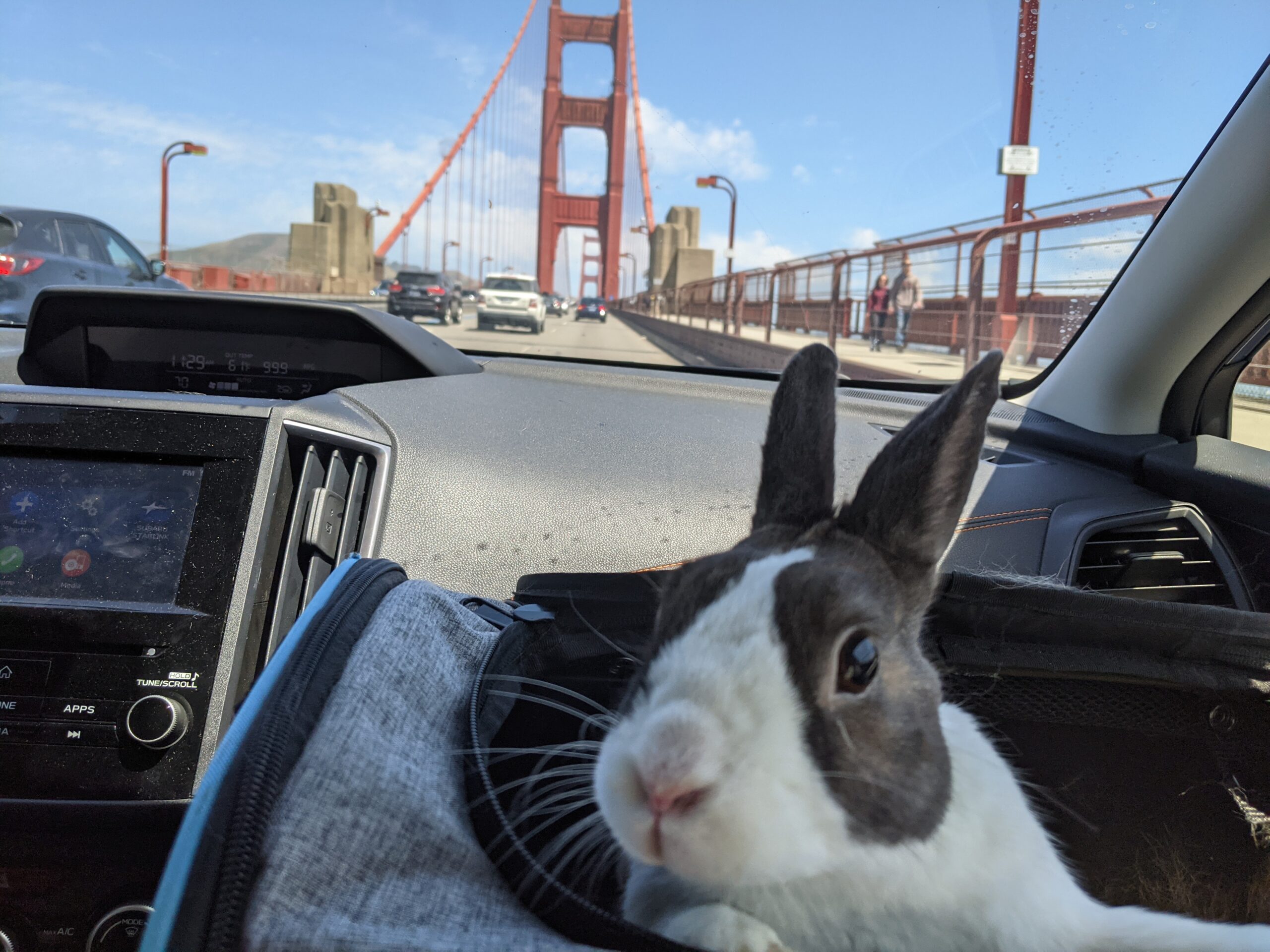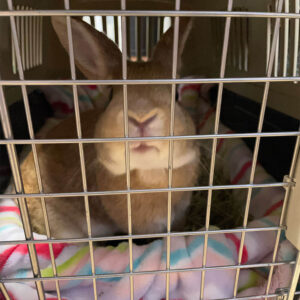When traveling is in your plans, whether it be a trip to the vet clinic, a vacation, or a move, plans will need to be made for your rabbit. Rabbits have different personalities and each will react in varying degrees to stress. But you should keep in mind that most rabbits are stressed by changes–unfamiliar surroundings, changes in routine, changes in type of food/water, and changes in temperature. Rabbits show stress in different ways, as well, such as by becoming withdrawn or aggressive, or refusing to eat. By planning carefully, you can minimize these stresses for your rabbit.
If you are planning a short trip, weekend away, extended vacation, or a permanent move, you have travel options.

Because there can be unexpected delays, take twice as much of all consumables as you anticipate will needed.
- Sufficient loose hay for the entire trip
- Pellets
- Bottles of water
- Fresh vegetables, especially leafy greens that can be served wet, which assist the rabbit in getting sufficient hydration during travel
- Water bowl and food bowl
- A portable litterbox
- Bedding for the litterbox
- Any medications
- Chew toys, etc.
- Garbage bags
- Vinegar (for cleaning) or enzyme cleaner such as Nature’s Miracle
- Hand broom/dustpan
- Newspapers
- Paper towels
- Ice packs or frozen water bottles for the rabbit to lie near
- Towels to soak in cool water for heat stress (Note: do not let a rabbit who’s been stroked with water lie near a frozen item; the frozen item will stick to the rabbit!)
- Infant rehydration solution such as Pedialyte (important because rabbits often become dehydrated while traveling)
- Powered supplemental food for syringe-feeding if needed such as Critical Care
- Syringes for assisted feeding if your rabbit is not eating
- Pet medical kit
- Health certificate and information about procedures at customs (if needed for foreign travel)
Prepare for Emergencies
- “Tattoo” your cell phone number in one of your rabbit’s ears with a nontoxic felt marker. The ink wears off but provides a temporary ID.
- Type short notes for your purse, suitcase, and car giving emergency instructions in case of an accident. This would include the email and phone number for an emergency contact who knows what to do with your rabbit or any other instructions for the rabbit.
- If you need a veterinarian on the road, look for one experienced with “exotics” and ask about their experience with rabbits [number of rabbits seen, which antibiotics they use for rabbits (no amoxicillin/ampicillin), whether fasting is advised for surgery (rabbits should not be fasted]. Generally avoid emergency clinics, because they are often unfamiliar with rabbits and are quite expensive.
Options for Your Rabbit's Vacation
Leave Your Rabbit(s) at Home
 Home alone? Do not leave your rabbit alone for more than 12 hours. Remember, a lot can go wrong for a rabbit in a 24-hour period–empty water bowl, home accident, illness. A reliable friend or relative who knows your rabbit or a trusted pet sitter who is knowledgeable about rabbits can come to you and your bunny’s home–preferably twice a day. As social animals, a rabbit left at home alone with a single visit per day, may be more “on guard” and less relaxed than one visited more frequently.
Home alone? Do not leave your rabbit alone for more than 12 hours. Remember, a lot can go wrong for a rabbit in a 24-hour period–empty water bowl, home accident, illness. A reliable friend or relative who knows your rabbit or a trusted pet sitter who is knowledgeable about rabbits can come to you and your bunny’s home–preferably twice a day. As social animals, a rabbit left at home alone with a single visit per day, may be more “on guard” and less relaxed than one visited more frequently.
Sitter introduction & instruction. Have your in-home bunny sitter meet with you and your rabbit at least a day before your trip to go over care and expectations. Provide written instructions for your rabbit’s feeding and cleaning routines, medicine regimen, signs of illness, and phone numbers for yourself, your veterinarian, and other people who can give advice on rabbits. It’s also helpful to portion out your bunny’s fresh vegetables for the first week into storage bags in the refrigerator. Be sure to discuss plans in case of an emergency–for you or your rabbit.
Helpful and reassuring suggestion: Install a pet camera so that you–or your sitter–can check in online and visit your rabbit while you are away.
Pros
- This is usually a more cost-effective option if you have multiple rabbits or a multi-species household.
- Feeding routine will be closer to their normal routine.
- Although pet sitters generally charge more than boarding fees, it can be more cost effective if you also have multiple pets.
- Your rabbit will be in familiar surroundings.
- If you use a veterinary technician or someone else experienced with rabbits, you can feel confident that any changes in the rabbit or symptoms of illness will be noticed.
- Your rabbit is not exposed to unfamiliar animals or what may be a noisy situation in boarding facility.
Cons
- Your rabbit may get lonely, especially if they are the only animal in the house.
- If your rabbit needs to be confined when left alone, they may not get adequate exercise.
- Having a sitter or neighbor who comes only once a day, leaves a lot of time for symptoms of illness to go unnoticed and makes it harder to maintain routines.
- If you have other pets such as dogs or cats, provisions may need to be made to ensure they do not bother the rabbit.
Board with an Experienced Bunny Sitter or Friend
 Not home alone. Unless you have numerous rabbits and other pets, having your bun stay with an experienced rabbit bunny sitter or with a friend who knows your rabbit well, is often the safest place to leave your bunny while you are away. Leaving only one or two rabbits in your home to be visited once or twice a day, leaves open the possibility that something may go wrong and unnoticed in a 12- or 24-hour period.
Not home alone. Unless you have numerous rabbits and other pets, having your bun stay with an experienced rabbit bunny sitter or with a friend who knows your rabbit well, is often the safest place to leave your bunny while you are away. Leaving only one or two rabbits in your home to be visited once or twice a day, leaves open the possibility that something may go wrong and unnoticed in a 12- or 24-hour period.
What to bring. Be sure to confirm with your sitter what supplies you will need to provide. And don’t forget to bring along your bunny’s favorite toys, blanket, and treats. Also discuss what to do in case of emergency. Is your approval needed before a visit to the veterinary clinic? Is your sitter okay to authorize vet costs up to a certain amount without your approval?
Vaccination, if needed. Do note that a reputable sitter who brings different rabbits into their home should require a copy of each of your rabbit’s vaccination certificates to confirm their current RHDV2 vaccine status, if the disease is endemic to your area. The initial vaccine requires 30 days to be considered effective, and an annual booster is required.
- Finding the bunny sitter: It’s always a good idea to get referrals.
- Contact your local House Rabbit Society chapter or educator for boarding options or referrals.
- Veterinarian technicians at rabbit-savvy veterinary practices sometimes offer pet sitting.
- Look on bulletin boards at veterinary offices, pet supply stores, and humane societies.
- Visit TrustedHousesitters–always make sure that your new house sitter knows rabbits!
Pros
- If the person you choose is familiar with rabbits, symptoms of illness may be more quickly recognized.
- Hopefully your rabbit will receive more attention than from a visiting sitter.
- There may be more opportunity for exercise time than if left at home.
Cons
- Your rabbit will be in unfamiliar surroundings.
- Other rabbits and pets may stress your rabbit.
Board at a Veterinary Clinic or Kennel
This is usually the least desirable option when leaving your rabbit behind. But if you choose this, there are several things you should consider:
-
- Ask to see where your rabbit will stay. Ideally, the rabbit should be in a room away from dogs and cats. If the rabbit will stay in the “cat room,” their cage should not face the cats.
- Check what supplies you need to provide.
- The clinic or kennel staff need to be experienced with rabbits.
Pros
- An experienced rabbit veterinarian can treat your rabbit should they fall ill or if they have a chronic health problem.
Cons
- Can be difficult to find a vet/kennel that has a desirable space separate from dogs and cats.
- Not all staff at these facilities may be familiar with rabbits, especially house rabbits.
- Unfamiliar surroundings and noise from upset animals may be stressful to your rabbit.
- Asking for updates on your bunny may take a while, especially if the facility is busy that day.
- It can be expensive, especially if boarding other pets, as well.
- Staff probably won’t be able to give much personal attention other than feeding and cleaning.
- Your rabbit most likely will not get out of their enclosure.
Take Your Rabbit with You
Bring Bunny Along? If you are going on an extended vacation with lots of sightseeing, you would probably do well to leave your rabbit at home. If you are going on vacation where you will be based at friends’ or relatives’ homes, you may be able to take your rabbit. However, you should make sure that your plans agree with your hosts and that there are no allergies to rabbits or their hay. (Many people are intensely allergic to timothy).
Moving? Of course, if you are moving, you will need to plan on how to move with your rabbit. also. People can–and should–bring their rabbits along when the family makes a move, whether it is down the street or a long distance. Rabbits are adaptable to new experiences. After all, when you adopted your rabbit, it was to provide a forever home. And your rabbit is an important part of your family, too. It just takes planning ahead.
Getting Their Car Legs. If your rabbit is not used to car rides (except to the vet), start regular car rides as early as possible before your actual trip. Start with short (30 minute) weekly or twice weekly rides in a pet carrier. Try to have some longer rides (one-three hours.) before the trip. Remember! Don’t leave your rabbit in a warm car at the store.
Long-distance or Multi-pet Car Travel. If you are moving long-distance and are also moving several animals, you might consider renting a panel van with no partition between the driver and cargo. This allows air conditioning and heat to better circulate. Place the carriers or traveling cages on top of carpet remnants or pads to minimize vibration, and secure the containers to the wall of the van.
Carrier or Travel Cage–But Not Loose
 Safe & Secure. It’s usually not a good idea to travel with your rabbit unconfined. A loose rabbit may climb under the seat, where it may be hot, or under the driver’s feet. If there is a car accident, a loose rabbit could be severely injured from being flung quite a distance into a solid surface. With a carrier–which should be secured to the seat for the same reason a rabbit should not be loose in the car–your rabbit will have protective walls and a solid roof.
Safe & Secure. It’s usually not a good idea to travel with your rabbit unconfined. A loose rabbit may climb under the seat, where it may be hot, or under the driver’s feet. If there is a car accident, a loose rabbit could be severely injured from being flung quite a distance into a solid surface. With a carrier–which should be secured to the seat for the same reason a rabbit should not be loose in the car–your rabbit will have protective walls and a solid roof.
Carrier Types. End-opening doors can make it difficult to lift the rabbit out, but they do make it easier for the rabbit to enter and exit on their own. Some carriers have a door on top. On the other hand, for extended car travel (more than a day, perhaps), a small traveling cage with a solid floor can provide more space for your rabbit to move and stretch. The collapsable variety for puppies can be convenient when traveling, for set-up in the car or at your destination,
Carrier Contects. The carrier should be tall enough to allow the rabbit to sit up. A large carrier or traveling cage may accommodate a small litter pan. If there is not space for the litterbox, then line the enclosure with a towel (changed often) or disposable puppy pads. Provide fresh hay and perhaps leafy greens (especially good for the moisture they provide) in the enclosure at all times. Offer water and small amounts of food during stops. Note that water bottles are notorious for leaking during travel in a carrier or cage.
- Look for ones that accept pets.
- Ask for a room on the ground floor of motels in the back if you are not sure of pet policy.
- Keep the rabbit in their carrier or traveling cage except for exercise in the bathroom.
- Hang the “Do Not Disturb” sign on the door at all times.
- It may be risky leaving the rabbit in the motel while sightseeing due to staff reaction and stress of being alone in an unfamiliar place.
- Explain your rabbit’s living conditions before you visit. Will they mind an indoor rabbit? Will there be space for exercising?
- Ask if they have allergies to animals or grass hay. People who are allergic to cats may or may not be allergic to rabbits. Even if they are not allergic to animals, your host might be allergic to timothy hay.
- Be diligent about cleaning up after your rabbit.
Rabbits cannot tolerate warm weather or heat.
- If the ambient temperature is above 75 degrees, place wet towels over the carrier or travel cage and provide access to a breeze.
- If you have no air conditioning or the weather is warm, set a frozen water bottle or container with ice where your rabbit can lie near or against it.
- If it is really warm, you can wet your rabbit’s ears. Again, do not let a damp rabbit lie near a frozen bottle.
- Do not leave your rabbit in a parked car. You may need to get food-to-go, take food along and stop in shaded rest areas, or wait until early morning and late evening to stop to eat.
Rabbits do not like drafts
- Carriers should not be placed where AC/Heat blows directly on them.
Water bottles often leak out all their water
- Rabbits tend to not drink much while traveling.
- However water should be offered at all stops.
- Add infant rehydration solution such as Pedialyte to combat dehydration. Be sure the rabbit will drink it before the trip. (They come in several flavors).
- You can also offer wet leafy vegetables to supplement hydration.
Rabbits may also not eat while traveling
- Offer favorite vegetables, pellets, and hay at all stops. Remember that the fresh produce can be wet.
- Provide fresh hay in the carrier while traveling.
- Offer food on rest breaks.
Create routines where you can try to establish consistent routines each day
- length of time in the car
- stopping times
- feeding and exercise times
Strap the carrier in place in the car, so that it does not slide in sudden stops.
“Imagine being a small animal inside a roaring, quivering airplane for several hours. Your ears may pop, probably for the first time in your life. The air on the floor where your box sits is hot and stuffy, or maybe quite cold. When finally let out, you’re in a totally unfamiliar place. Ask yourself, is this an experience your rabbit really needs?”
–B. Woolbright, House Rabbit Journal, Vol.2, #12
- The answer may be yes if this is the only way to get your rabbit to your new home or if you have an outgoing, calm rabbit who doesn’t mind new experiences.
- Information on which airlines currently accept rabbits in the cabin is available here.
- The United States Department of Agriculture (USDA) has information on air travel and pets here.
Additional Factors to Consider
- Rabbits who are nervous, fear the vacuum cleaner, tremble in the car, or who are older or have health problems will most likely find a plane trip too stressful.
- Rabbits who are calm and not bothered by car rides and new places will cope better but may still find planes weird and scary.
- A one-to-two hour plane trip may be better than a 10-hour car ride. However, four days in a car may be less stressful than an all-day trip with multiple take-offs and landing, changing planes, or traveling to and from airports.
If you choose to fly with your rabbit, you will need to make these preparations
- Make a reservation well in advance. There will be a fee for your rabbit to fly, regardless of whether your rabbit is in cargo or under your seat.
- Shop around for an airline that will allow you to bring your rabbit into the cabin. Some allow pets in the cabin, but not rabbits. Most allow only one animal in the cabin per flight.
- Contact the airline to find out what type of carrier you will need:
- Under-the-seat carriers cannot be any larger than 8″ x 17″ x 12, which is too small for most large rabbits.
- The type with a top-opening door allows you better access to your rabbit.
- Line the carrier with paper towels, puppy pads, or newspapers and hay. Do not take your rabbit out of the carrier in-flight. If multiple rabbits over time escape their carriers and run free through the cabin, the airline may ban rabbits from the cabin in the future.
- Bring fresh vegetables, pellets, hay, treats, and bottles of water in your carry-on bag to offer on layovers.
- Also bring medical supplies and other supplies listed above.
- Check with the airline on their requirements for a health certificate. You may need to visit an unfamiliar veterinarian before your return flight home.
- Acustom your rabbit to travel ahead of the trip. You can take them in their carrier on car rides regularly at least one month prior to the plane trip. If possible, work up to car rides of an hour or more.
Cargo Realities
Not all airlines will allow you to have your rabbit with you in the cabin or you may find airlines that allow rabbits in the cabin too expensive. Many airlines will only allow them to be in the cargo. If so, be sure your rabbit and the airline are prepared for it. Airlines also seem to regularly change their policies with regard to rabbits.
- Carriers are loaded from baggage carts while engines are idling. People wear earmuffs; rabbits don’t.
- Cargo is pressurized and has limited temperature control, but these are not activated on the ground.
- Animals cannot be boarded if ground temperature on the tarmac at departure or destination is too hot or cold, so the possibility exists that your rabbit might not get on the same flight as you.
- Adjusting your travel time to earlier or later in the day according to the temperatures may help.
- A generous tip to a sky-cap may get your rabbit hand-delivered.
- Try to get your rabbit hand-delivered to you and to the plane rather than letting them be put on a conveyor belt or baggage cart.
Remember that the key to traveling with your rabbit–or what to do if your bunny needs to stay home–is to plan ahead and be prepared.
If you decide your house rabbit needs to stay behind on your trip, House Rabbit Society can help. In addition to rescuing rabbits who have been abandoned, House Rabbit Society and many of our chapters provide boarding services for families who may need a safe, stimulating place for their rabbits stay while you’re away from home.Sign up to Our Newsletter!
Sign up for web update alerts and our monthly e-newsletter
to stay current on HRS, our Chapters, and info for your bunny.



